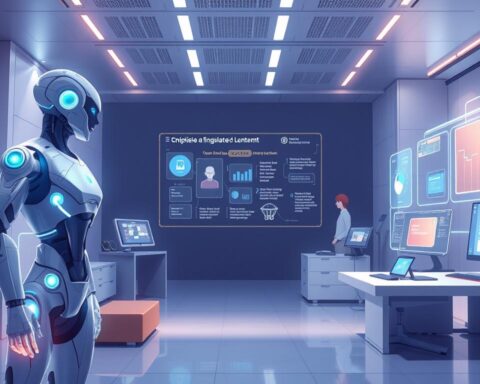The global market for AI in education is set to hit about $20 billion by 2027. This shows big chances in the language learning field. It’s because of AI’s growth and the need for learning that fits each person.
AI helps make learning plans that fit each user’s needs. This makes learning more fun and helps people learn better. AI is changing how we learn, making it easier and more effective.
More than 60% of schools plan to use AI in their language classes by 2025. This is because AI makes learning better and more personal. The language learning market is expected to grow to $115 billion by 2025, thanks to AI and technology.
Introduction to AI in Language Learning
AI is changing education, making it more personal and effective. It helps with learning plans, grading, and even admin tasks. This lets teachers focus on teaching, while AI handles the rest.
Key Takeaways
- The global market for AI in education is projected to reach $20 billion by 2027.
- 70% of learners prefer personalized learning experiences, which AI in Education and Training can provide.
- AI-powered language learning platforms can analyze user strengths and weaknesses to offer personalized learning paths.
- The global language learning market is projected to grow to $115 billion by 2025.
- AI in education is transforming K-12 learning by providing personalized and adaptive learning solutions.
- Effective AI in education needs teacher training and open communication with all involved, ensuring AI’s successful use.
Introduction to AI in Education and Training
AI is changing education by making learning personal and flexible. It’s a big deal in teaching technology. A survey found 60% of teachers use AI in class. Most think it makes learning better.
AI is not just for language learning. It helps in many ways. It gives feedback, fixes pronunciation, and tailors lessons.
AI makes learning more efficient and accurate. It also makes students more interested. But, there are worries about cheating and fake information. As education grows, AI’s role is key to its future.
Current Trends in AI-Driven Language Learning
AI is changing how we learn new languages. Now, automated learning systems make learning personal. They match what you need and can do. This trend is growing, with AI in education set to expand a lot.
Virtual tutoring with AI is a big deal now. It offers one-on-one help. This helps learners feel less scared to speak and get better at grammar and pronunciation. AI chatbots can answer in many languages, helping more people learn.
Adaptive learning systems are also important. They change based on how you do, giving feedback right away. This keeps you interested and learning more. As people want more fun and interactive learning, AI is ready to help.
Key Players in AI Language Learning Solutions
The world of AI in language learning is changing fast. Big companies and new startups are leading the way. Duolingo, for example, helps people learn over 40 languages with AI.
Other big names like Carnegie Learning and Knewton use AI to help with math, reading, and languages. They make learning personal and smart, helping students learn better.
New companies like Sana Labs and Spark School are also making a big impact. They use AI to make learning fit each person’s needs. As AI in learning grows, these leaders will make learning fun and easy for everyone.
AI-Powered Language Learning Tools
AI-powered tools are changing how we learn languages. They use machine learning for training to give each learner a special plan. This plan fits their own pace and style.
These tools help learners get better at speaking, using words, and grammar. They make learning fun and effective.
For example, AI-powered learning solutions create lessons and activities just for you. Tools like Quizlet and GetPronounce help with speaking. They give feedback right away.
Teachers can use these tools to do their jobs better. They can spend more time teaching and helping students. As AI grows, we’ll see even more cool ways to learn languages.
Benefits of AI in Language Education
AI in language education brings many benefits. It makes learning more fun and exciting. Teachers can now tailor lessons to fit each student’s needs.
This makes learning better and more meaningful. Students are more likely to enjoy their studies.
Cognitive computing helps a lot in this area. It makes learning systems that change to fit each student’s way of learning. For example, AI tools can see where students need help and give them extra support.
- Personalized learning experiences
- Adaptive learning systems
- Enhanced accessibility for diverse learners
- Increased engagement and motivation
By using AI tools, language education can get even better. This leads to better learning and more success for students.
Challenges and Limitations of AI in Language Learning
AI is changing how we learn languages. But, it faces some big challenges. One big worry is data privacy. AI needs our personal info to work well.
Another big problem is the lack of human touch. AI can’t replace real people in learning. It can also cause mistakes in talking.
Some main issues with AI in learning languages are:
- Bias in AI algorithms, which can perpetuate discrimination and inequality
- Lack of human empathy and understanding, leading to inadequate support for learners
- Technical issues, such as access to reliable internet and necessary hardware
But, AI tools for learning languages are showing good results. Studies show they help with speaking, words, and understanding better. We need to fix the problems to make AI learning better.

To beat these problems, we must make AI systems better. They should keep our data safe, avoid unfairness, and learn with us. This way, AI can really help us learn languages better.
The Role of Educators in an AI-Enhanced Classroom
As we add AI to schools, we see how important teachers are. AI helps teachers make learning plans just for each student. This lets teachers spend more time helping students grow.
A report from Training Magazine says AI makes teaching better. It helps teachers and students learn more together.
Teachers use AI to make lessons fit each student’s needs. They can see where students need help and give them the right support. This makes learning better and helps teachers connect with students.
AI helps teachers teach in new ways. Students can learn by solving problems and thinking deeply. This lets them explore and learn about the world around them.
Some great things about AI in schools are:
- Learning plans that fit each student
- Learning that changes as students grow
- Help for all kinds of learners
We need to help teachers learn about AI. This way, they can use AI tools well in class. This helps create a place where students can grow, be creative, and think deeply.
Case Studies: Successful AI Language Learning Programs
AI is changing education a lot. Many schools have added AI to their language classes. This has made learning better and helped students do better.
Using machine learning helps a lot. AI looks at lots of data to give feedback and adjust lessons. This makes learning fit each student’s needs.
Here are some examples of AI helping in language learning:
- The University of Sydney used Smart Sparrow for better learning paths. Students got more involved and did better in school.
- New Town High School used Maths Pathway. Students did better in math, with higher scores.
- The “Help Me See” app at the University of Alicante helped visually impaired students. They got more involved in campus life.
These stories show how AI can change language learning. It makes learning more fun, easy, and effective. As education keeps changing, AI will be key in shaping language learning’s future.
The Future of AI in Language Learning
Cognitive computing for education is changing how we learn languages. Technology in educational training keeps getting better. This means we’ll see more personalized learning soon.
AI can look at lots of data. It finds out what you’re good at and what you need to work on. Then, it gives you lessons that fit just right.
Predictions and Trends to Watch
- More people will use AI for learning languages.
- Virtual and augmented reality will become big in language classes.
- AI will help with tests and checking how well you’re doing.
Potential Market Growth
The market for learning languages is going to grow a lot. More people want to learn languages well and fast. Technology in educational training and cognitive computing for education will help make language learning better.
Monetizing AI Language Learning Solutions
More people want AI language learning tools. Companies are finding ways to make money from this. They offer automated learning systems for a fee. This lets users get many tools and resources.
They also have virtual tutoring with AI. This gives users a personal learning experience and feedback right away.
Companies also make money by licensing their tools. They sell them to schools, companies, and other groups. This way, they make money and reach more people.
There are more ways to make money too. Like ads, sponsored content, and data analysis. AI helps create new and better learning tools. This meets user needs and helps businesses grow.
Ethical Considerations in AI Language Learning
AI in Education and Training is growing fast. But we must think about its ethics. It can change how we learn, but it also brings up issues like bias and fairness.
Studies show AI can keep old biases alive. This hurts some students more than others. It’s key to use diverse data to train AI.
Here are some important points for ethical AI learning:
* Be clear about data use and who owns it
* Stop AI from being biased or unfair
* Keep checking and improving AI systems
* Make sure AI teams are diverse and include everyone
By focusing on these points, we can make AI learning better for everyone.
Government and Institutional Support for AI in Education
Many governments and schools are helping AI in education. They do this through new rules and money for projects. This help is key for using machine learning for training and AI-powered learning solutions.
Recently, 83% of teachers in schools used AI tools. This shows AI is getting more popular in schools.
Some places have made rules about AI in schools. For example, Tennessee wants schools to make their own rules about AI. New York has banned AI that recognizes faces in schools. Los Angeles is making AI-powered platforms for learning.
The EducateAI project wants to give everyone good AI education. It focuses on groups that don’t usually get into tech. The National AI Research Resource pilot aims to make AI education available to more people.
It’s important to check AI tools often to avoid unfairness. Schools should also share knowledge about AI. By supporting AI in schools, we can make learning better and more fair. This uses the power of machine learning for training and AI-powered learning solutions.
Conclusion: The Path Ahead for AI in Language Learning
Technology will change how we learn languages a lot. It will make learning more personal and fit each person better. This will make learning languages easier and more fun for everyone.
AI can do many cool things in language learning. It can make virtual worlds and smart helpers. Teachers can use these tools to make learning fun and right for each student. AI can also help teachers with their work, so they can teach more.
We need to make sure AI is fair and open. This means making sure it works well for everyone. If we do this, AI can really help make learning better for everyone.
FAQ
What is AI in language learning and how does it enhance the learning experience?
What are the benefits of AI-powered language learning?
What are the current trends in AI-driven language learning?
Who are the key players in AI language learning solutions?
What are the challenges and limitations of AI in language learning?
What is the role of educators in an AI-enhanced classroom?
What are the benefits of AI in language education for diverse learners?
How can AI language learning solutions be monetized?
What are the ethical considerations in AI language learning?
What is the future of AI in language learning?
How can government and institutional support promote AI integration in education?
Source Links
- AI’s impact on language learning – https://www.pearson.com/languages/community/blogs/2023/12/ai-and-language-learning.html
- The role of AI in modern education – https://onlineprograms.education.uiowa.edu/blog/role-of-ai-in-modern-education
- Artificial Intelligence In Education: Teachers’ Opinions On AI In The Classroom – https://www.forbes.com/advisor/education/it-and-tech/artificial-intelligence-in-school/
- AI education and AI in education – https://www.nsf.gov/science-matters/ai-education-ai-education
- How artificial intelligence is revolutionizing language learning – https://www.berlitz.com/blog/artificial-intelligence-ai-language-learning
- Challenging traditional methods: Understanding AI-driven innovations in language teaching – https://www.pearson.com/languages/community/webinars/ai-driven-innovation-in-language-teaching.html
- 21 AI in Education Examples to Know | Built In – https://builtin.com/artificial-intelligence/ai-in-education
- The Top 10 AI-Powered Learning Platforms in 2025 – https://360learning.com/blog/ai-learning-platforms/
- Top AI Companies Revolutionizing Education – https://aisuperior.com/ai-companies-for-education/
- 7 AI Tools That Help Teachers Work More Efficiently – https://www.edutopia.org/article/7-ai-tools-that-help-teachers-work-more-efficiently/
- Top 7 AI Tools for Language Teachers and Language Learners – ATC Language Schools – https://atclanguageschools.com/top-7-ai-tools-for-language-teachers-and-language-learners/
- AI in Schools: Pros and Cons – https://education.illinois.edu/about/news-events/news/article/2024/10/24/ai-in-schools–pros-and-cons
- 5 Pros and Cons of AI in the Education Sector – https://www.waldenu.edu/programs/education/resource/five-pros-and-cons-of-ai-in-the-education-sector
- The challenges of AI in language teaching – Dexway – https://www.dexway.com/the-challenges-of-ai-in-language-teaching/
- Language Learning in the Age of AI: Challenges and Opportunities – https://medium.com/@iPadEFLTeacher/language-learning-in-the-age-of-ai-challenges-and-opportunities-a5a8353bedd4
- How AI Is Changing The Role Of Teachers In Education – https://www.forbes.com/councils/forbestechcouncil/2024/10/02/how-ai-is-changing-the-role-of-teachers-in-education/
- The Evolving Role of Educators in the Age of AI | Katie Martin – https://katielmartin.com/2023/06/20/the-evolving-role-of-educators-in-the-age-of-ai/
- Use of AI in Schools [25 Case Studies] [2025] – https://digitaldefynd.com/IQ/ai-in-schools-case-studies/
- AI in Education: 39 Examples – https://onlinedegrees.sandiego.edu/artificial-intelligence-education/
- 5 AI Case Studies in Education | VKTR – https://www.vktr.com/ai-disruption/5-ai-case-studies-in-education/
- AI in Education in 2024: Educators Express Mixed Feelings on the Technology’s Future – https://edtechmagazine.com/k12/article/2024/09/ai-education-2024-educators-express-mixed-feelings-technologys-future-perfcon
- The Future of AI in Education: Pioneering a New Era of Learning — ITRex – https://itrexgroup.com/blog/the-future-of-ai-in-education-pioneering-a-new-era-of-learning/
- Embracing the future of Artificial Intelligence in the classroom: the relevance of AI literacy, prompt engineering, and critical thinking in modern education – International Journal of Educational Technology in Higher Education – https://educationaltechnologyjournal.springeropen.com/articles/10.1186/s41239-024-00448-3
- Monetizing AI: Ensuring ROI for Your AI Solutions – https://cpl.thalesgroup.com/software-monetization/monetizing-ai
- Revolutionizing Education with AI: From Forecasting to Monetization – https://ibl.ai/blog/revolutionizing-education-with-ai-from-forecasting-to-monetization
- Ethical AI for Teaching and Learning – https://teaching.cornell.edu/generative-artificial-intelligence/ethical-ai-teaching-and-learning
- Artificial intelligence in education: Addressing ethical challenges in K-12 settings – https://pmc.ncbi.nlm.nih.gov/articles/PMC8455229/
- Ethical principles for artificial intelligence in education – Education and Information Technologies – https://link.springer.com/article/10.1007/s10639-022-11316-w
- III. The Current State of Artificial Intelligence in Education | NEA – https://www.nea.org/resource-library/artificial-intelligence-education/iii-current-state-artificial-intelligence-education
- NSF launches EducateAI initiative – https://www.nsf.gov/news/nsf-launches-educateai-initiative
- AI in higher education: Implementation strategies for institutions and tech partners – https://www.highereddive.com/spons/ai-in-higher-education-implementation-strategies-for-institutions-and-tech/735434/
- AI in Education: The End of Schools As We Know Them? – https://www.louisbouchard.ai/ai-in-education/
- How AI is Revolutionizing Education and Learning for the Future? – https://medium.com/@aileenscott604/how-ai-is-revolutionizing-education-and-learning-for-the-future-c288543209e3
- Artificial Intelligence and the Future of Teaching and Learning – https://www.engageli.com/blog/artificial-intelligence-and-the-future-of-teaching-and-learning









